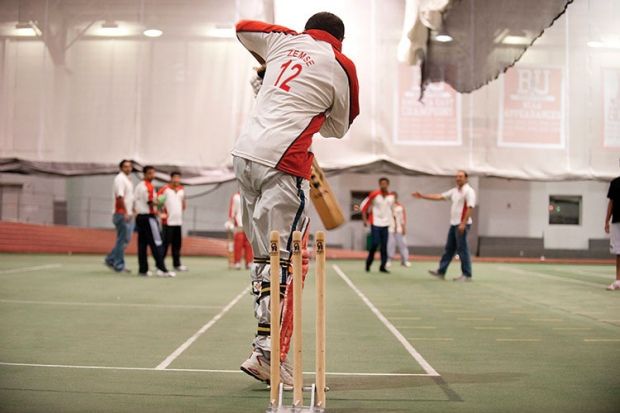Source: Melody Komyerov/Boston university
No longer on the back foot: US college cricket is growing massively
With a run-up and delivery that appears almost choreographed, the bowler puts impressive speed on the ball. Then the batsman hits it skilfully between fielders, to the delight – and occasional confusion – of the handful of onlookers standing alongside the pitch.
The game is familiar but the setting may be unexpected. This cricket match has pitched Boston University against cross-river rival Harvard University, two of a sudden swell of new teams at American institutions playing a sport that has, until recently, remained largely unknown in the US.
From just five university cricket clubs that played in the inaugural US championship four years ago, more than 20 now participate. There are more than 70 clubs in all, in every region of the country.
“The pace with which it’s taken off is unbelievable,” said Hayat Khan, president and captain of the Boston University club, which was one of the first of the new wave (and beat Harvard by two runs). “There’s been a huge surge of interest.”
That surge is a result of Americans’ unrelenting thirst for new sports, and of immigration from South Asia and the Caribbean, where cricket is hugely popular. It has also spawned cricket teams in 30 secondary schools in New York City – where Mr Khan, whose parents are immigrants from Pakistan, first played – and amateur leagues in many US states. Even the New York Police Department has a team.
But the biggest driver of the trend is the continued increase in the number of international students at US universities, which has grown to a record three-quarters of a million, many of them from cricket-playing countries: 13 per cent come from India alone.
In the South, it was a transplanted Englishman, Geoffrey Wainwright, who formed a league composed of students from Duke University when he went there to teach at the Divinity School. The league also drew on students from the University of North Carolina and North Carolina State University.
“Being a Yorkshireman, I’m interested in cricket wherever I go,” said Dr Wainwright.
There are also cricket clubs at California State University, Long Beach, Cornell University, Dartmouth College, Indiana University, the Massachusetts Institute of Technology, Northwestern University, the University of Pennsylvania, Princeton University, the University of Southern California, Virginia Tech, West Texas A&M University and Yale University.
Universities, for whom international students are lucrative sources of revenue, are encouraging the cricket fad and often feature photographs of cricket matches in their promotional materials. Boston, which has more than 6,000 overseas students, has even launched a course to teach cricket to undergraduates who don’t know how to play it; 10 are enrolled this semester.
Many Americans unfamiliar with the sport have also joined the clubs, often out of curiosity.
“They know about baseball, so they have some of the fundamentals, and it’s not so hard to switch over,” Mr Khan said. “People are very eager to take a swing at the ball” with a different shaped bat. “They’re also interested in the delivery of the ball. There’s an art to it.”
Some challenges remain: the biggest is finding places to play. The Boston club uses a women’s hockey field on top of a garage; it is smaller than a regulation cricket pitch and has synthetic turf, but it is better than what is available to many other university cricket clubs.
Cricket was once the predominant sport in the US. It was played by colonial soldiers during the Revolutionary War and was established at many universities as early as 1833, when a team was formed at Haverford College. But in the late 19th century it was swiftly supplanted by baseball. Harvard’s original team, which started up in 1868, was shut down in 1902.
“The game itself has an American history,” said Lloyd Jodah, a Caribbean immigrant of Indian descent who is head of the four-year-old governing body American College Cricket. “It was the original American sport. All that has been lost in the mists of history.”
But those mists are clearing. Although new, the US university cricket clubs play at a high level, Mr Jodah said. “We have students here who could have easily played at a significant level in India, for example, so we’ve got a skill base.”
And now, rather than having to go out of his way to recruit players, Mr Jodah said, “I get contacted by random students who want to start cricket clubs at their schools.”
“Cricket”, he continued, “has lost its American presence and identity. What we’re trying to do is bring it back.”
Register to continue
Why register?
- Registration is free and only takes a moment
- Once registered, you can read 3 articles a month
- Sign up for our newsletter
Subscribe
Or subscribe for unlimited access to:
- Unlimited access to news, views, insights & reviews
- Digital editions
- Digital access to THE’s university and college rankings analysis
Already registered or a current subscriber? Login




